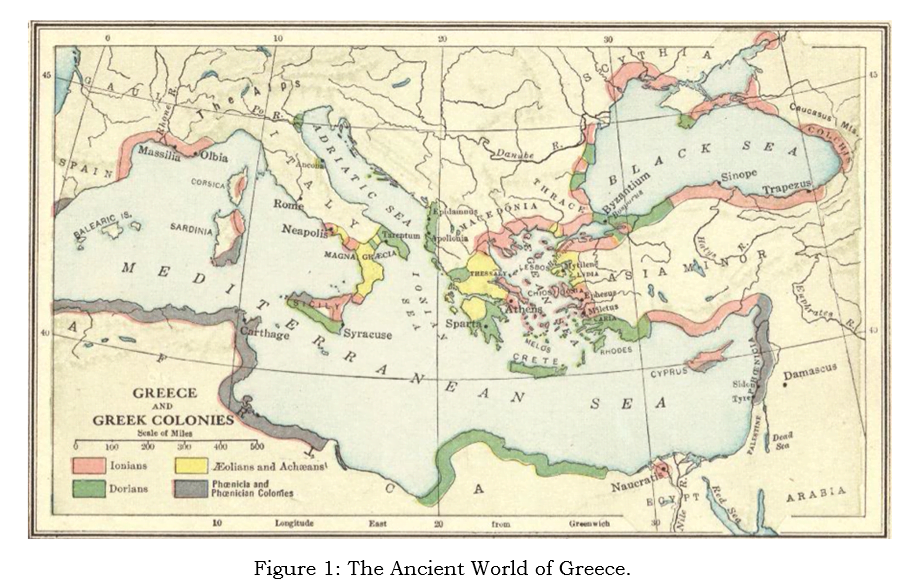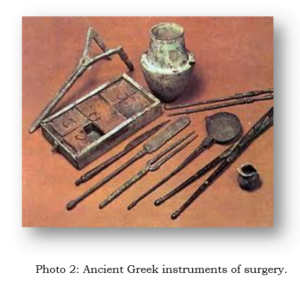by Athanasios N. Komianos, BA, CHT, CRT
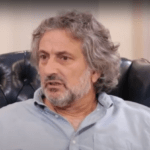 More than three thousand years ago an impressive practice took place in the lands of the Ancient Greek world. A form of therapy unknown till then, and probably unprecedented, called Enkoimisis. Modern scholars accept that this kind of therapy should be considered the predecessor of modern psychotherapy. It seems there are elements that resemble, in a sense, today’s trance hypnotherapy.
More than three thousand years ago an impressive practice took place in the lands of the Ancient Greek world. A form of therapy unknown till then, and probably unprecedented, called Enkoimisis. Modern scholars accept that this kind of therapy should be considered the predecessor of modern psychotherapy. It seems there are elements that resemble, in a sense, today’s trance hypnotherapy.
The Ancient World of Greece
Since the time of written records there are notations of Enkoimisis in the temples of the god of Medicine, Asklepios. One of the first such reports is in Homer’s Iliad (written in the 8th century B.C. but refers to the 13th century B.C.) in which Machaon and Podaleirios, the two sons of Asklepios, are the chief doctors of the Greek army. In the same work it discusses Manteis and the Oracles of Greece. Manteis were the seers or diviners who had the ability to foresee the future, while the Oracles were the state protected major sanctuaries of god Apollo. According to the legend, Apollo is the father of Asklepios. In other words the father of the god of medicine is the god of Light. The most notorious Oracle was that of Delphi and it flourished for more than a millennium. There the priestesses, the Pythonesses, were to give their oracles under deep and excessive trance. Only states and kings could ask for an oracle there.
On the map (Figure 1) the area of Greek colonies extended to most of the seashore of the Mediterranean basin, from the shores of Asia Minor to the areas of Southern Italy and Sicily. In this great area there existed 320 temples of Asklepios in which Enkoimisis was practiced daily.
It would be interesting to note here before I expand deeper into the process of enkoimisis (incubation) that at the same time there existed two other sorts of sanctuaries in Ancient Greece which also employed trance states to achieve results, the Oneiromateia and the Nekromanteia.
There were four Nekromanteia in antiquity, two in the mainland of Greece almost 500 kilometers apart, one in the lands of Minor Asia and one in Southern Italy at least one thousand kilometers apart. Nekros means dead in Greek. People would resort there to communicate with their dead, not any dead, but those who left life abruptly, unexpectedly and who had unfinished business and leftovers. Modern academics suggest that the priests operating in the Nekromanteia were, in a sense, fooling the mourning relatives by orchestrating plays that deceived the naïve people. They created the delusion that they really talked to the apparition
of their dead loved one. Nothing could be farther than the truth. Reenactments and attempts to reproduce this practice induced similar results and spectacular reports of contact with the dead were achieved (Moody 1994). In some cases, not only was there salvation of the pain of loss, but also details unknown to the living were given by the dead. No one would walk or ride on a donkey to cross a dangerous land of mountains and rivers to let themselves be fooled by belligerent priests who make a living out of deluding people. Testimonials exist from thence, which support the fact that these communications seemed to be real to the bereaved.
Also there were twelve Oneiromanteia in Ancient Greece. In those sanctuaries people would resort, not for therapy, but to have access through dreaming to future events. Precognition was feasible for them. There, they sought pieces of information that could give them solutions to personal issues, dilemmas, relationships or business matters. The ritual was similar to that of the sanctuaries of Asklepios but not the same.
Asklepieia the hospitals of Antiquity
Initially, the chambers of dream healing were caves that served as natural places of worship of the god. Patients would lie still on the ground in the chambers as if laid in a lair. It was not only as if one was going to mother earth’s womb but to the underground chamber of the chthonic (underground) powers as well. Asklepios, according to the legend, was the son of a god (Apollo) and a human (Koronis). Asklepios was trained into healing by centaur Cheiron, at mountain Pelion. Cheiron was an herbalist and taught Asklepios all the secrets about flora and fauna.

Eventually and as economic growth was achieved, temples were built in areas where position was important. The sanctuaries were always built in places of supreme beauty, where rejuvenating running water from springs was available all year long. Usually, they were built next to Apollo’s temples. It is important to note here that in antiquity, no city, or temple, and sanctuary would be built without the permission and the correlates given by the oracle at Delphi. The place had to be blessed by the god of Light. In latter times, the laying on the ground was replaced by comfortable couches called the klinai. In contrast to the analytic couch of today the klinai was intended for sleeping, incubation and dreaming. The word clinic we use for hospitals today comes from this couch. As you can clearly see in Photo1, the patient lies on the klinai and Asklepios is inducing trance to her, probably by passes.
All kinds of treatments took place there. Physical ailments were treated physically and surgeries were conducted daily. Thousands of surgery tools have been dug up in excavations testifying to the fact that these sanctuaries served indeed as the hospitals of antiquity. All kinds of surgical instruments have been found from lancets, scalpels, forceps and tweezers to pullers, probes and catheters diopters and speculums (photo 2). There are written recipes of herbal salves and medicines that were used on specific ailments.
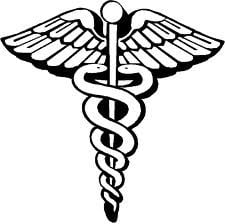 The word pharmacy comes from the Greek word pharmakon (φάρμακον) which means drug, medicine,
The word pharmacy comes from the Greek word pharmakon (φάρμακον) which means drug, medicine, or poison. Doctors and pharmacists use the caduceus, (shown on left) as their symbol. The truth is that
or poison. Doctors and pharmacists use the caduceus, (shown on left) as their symbol. The truth is that
in Gutenberg’s time there was a typographical error that still haunts us and has not yet been corrected. A technician inserted the caduceus of Hermes, depicted on the left, instead of the intended caduceus of Asklepios, which is depicted on the right. The serpent of Asklepios was a major part of the therapeutic process and in many instances this serpent appeared in the dreams of the incubators and led to the catharsis of the patients.
The preparatory stages before enkoimisis
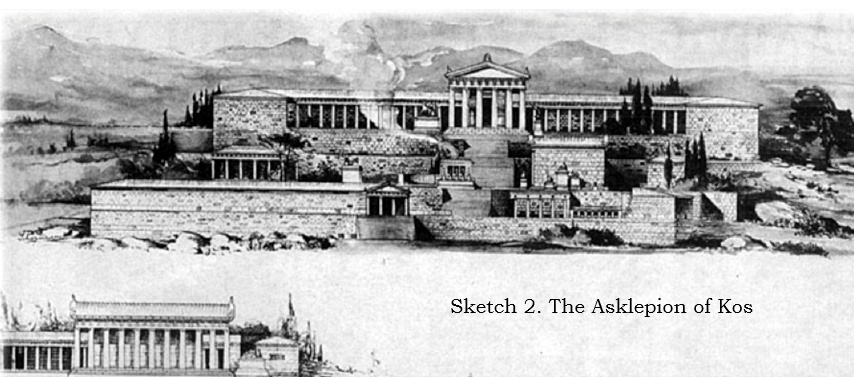 Patients who wanted to experience enkoimisis had to be dedicated and devoted to that end. They would be willing to fast from toxic foods and drinks for a long span before they started their long trip to the shrine. They also had to abstain from indecent behavior.
Patients who wanted to experience enkoimisis had to be dedicated and devoted to that end. They would be willing to fast from toxic foods and drinks for a long span before they started their long trip to the shrine. They also had to abstain from indecent behavior.
As it has already been mentioned, these temples were built in places of supreme beauty where water fountains existed. Next to the sanctuaries were gymnasiums, as well as theatres, where patients could spend time before the process of therapy. Patients were expected to indulge in hydrotherapy, massage, physical exercise at the gymnasiums, and even participate either as spectators, or as actors in theatrical plays. This extensive, preparatory phase was a prerequisite of therapy. The healing effects of psychodrama were already very well-known at antiquity. By identifying themselves with the actors they were, in a sense, able to project their problems elsewhere. This can clearly been seen in the definition given to the word “tragedy” by Aristotle:
Tragedy is, then, an enactment of a deed that is important and complete, and of [a certain] magnitude, by means of language enriched [with ornaments], each used separately in the different parts of the play: it is enacted, not [merely] recited, and through pity and fear it effects relief catharsis to such emotions.
The Final Day
Before the incubation a cleansing process should take place. This process was called katharmos. It was not only a physical cleansing but a symbolic one as well. Ritual libations and sacrifices of roosters would be done on the altar dedicated to the healing god. Finally, patients would dispose of their clothing and wear a white robe, which also symbolized a cleansing procedure. Patients during the last day were expected to drink only water.
The “Intake Interview”
“The patient must be interviewed. By means of these questions, it is possible to learn a great deal concerning the illness, which enables a better treatment. The time that the illness begins is also important. In addition, one should inquire as to the patient’s attitude toward life and general mental state. In this way, the patient’s mental health can be assessed.”
Rufus of Ephesus (1st Century AD)
Before entering the sleep temples, patients had to converse with the therapeutes (physicians/priests) about their problems and symptoms. Not all patients would be accepted. Only those that the priests judged were capable of healing were accepted.
When accepted the patients would have to drink water from the fountains for purification. Then they would have to walk through the tholos (θόλος). According to the Edelsteins “the meaning and the use of the circular labyrinth of the tholos which has been found in several Asklepieia is unknown to us” (Edelstein, 1945/1998). The particular structure can induce altered states of consciousness.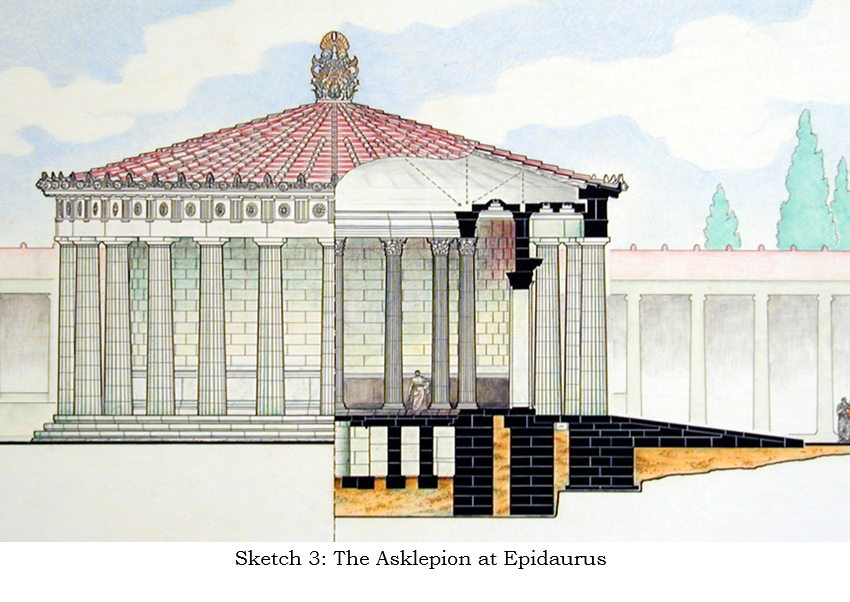 On Sketch 3, there is depicted an underground part on this building where the labyrinth is located while the figure of a man standing on the ground level can offers a sense of perspective of the magnitude of the building. Photo 3 depicts what is left of it. Professor Kontaratos recently offered his insights in understanding what took place in the tholos.
On Sketch 3, there is depicted an underground part on this building where the labyrinth is located while the figure of a man standing on the ground level can offers a sense of perspective of the magnitude of the building. Photo 3 depicts what is left of it. Professor Kontaratos recently offered his insights in understanding what took place in the tholos.
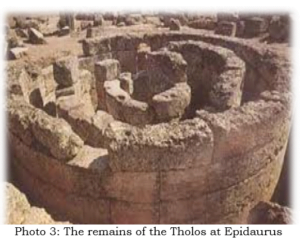 The patient had to enter this underground level of the tholos (photo 3) and find his/her way through it in total darkness. There was only one opening from one ring to the next. Thus while walking in total darkness the patient had to figure his or her way to the next internal ring. The goal was to reach the central part of the labyrinth were the light of an oil lamp was lit.
The patient had to enter this underground level of the tholos (photo 3) and find his/her way through it in total darkness. There was only one opening from one ring to the next. Thus while walking in total darkness the patient had to figure his or her way to the next internal ring. The goal was to reach the central part of the labyrinth were the light of an oil lamp was lit.
As soon as that was achieved, then the central stone of the ground floor above their heads was raised so that the patients could elevate themselves on the ground floor structure.
What is the purpose of this Labyrinth? The round structure symbolizes the cycle of birth and rebirth.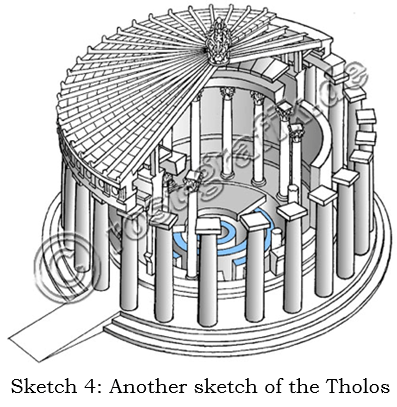 So it seems to be an initiation labyrinth. The underground floor symbolizes the world of matter, the world of the here and now, while the upper floor symbolizes the heavens and the afterlife.
So it seems to be an initiation labyrinth. The underground floor symbolizes the world of matter, the world of the here and now, while the upper floor symbolizes the heavens and the afterlife.
The building is standing in two different kinds of alcoves. The outer part is made of 26 Doric rhythm columns and symbolizes the outer world of ignorance, darkness and lack of knowledge. On the contrary, the inner part is made of 14 Corinthian rhythm columns that symbolize the cultivated, cultured and initiated person[1].
In other words, patients who underwent the long period of fasting and purification, of waiting in anticipation while at the same time hearing rumors of wonderful cures, were affected by this process.
After crossing the tholos, patients were clothed in a special white gown with purple stripes and were led to the abaton (άβατον).
The way to the Abaton
These sanctuaries or caves were usually full of (non-poisonous) snakes. On their way to the abaton patients had to walk over these snakes and overcome their deepest fears.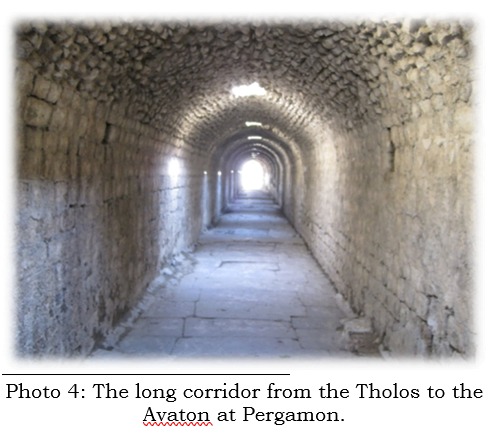
Enkoimisis is mostly known as incubation. During this process animation was temporarily suspended in what was called “Mother Earth’s womb”. Patients after entering the abaton would lie down on the klinai, or in holes, or in caves and would be wrapped in white sheets. Like cocoons, patients lay still in a lair. Absolute darkness, sensory deprivation and silence along with natural fear would most certainly elicit trance, or, altered states of consciousness.
That was the highlight of the treatment; incubation in total darkness and stillness in anticipation of the much desired onar. Onar being a “dream proper” that would in itself bring on the cure (Ellenberger 1970). Deep healing was achieved when the onar would come. The onar was a dream or a vision that would act as a catalyst on the patient’s health. In these dreams either Asklepios or a symbol of his (a dog, a snake, or a cock) or his helper Telesphoros would appear in the vision and contribute to healing. The objective was healing. As Ellenberger states:
During the night the patient spent in the abaton, he might see apparitions, receive an oracle, or have visions of dreams.An apparition meant that the patient, while still awake, saw the figure of a god, mostly Asklepios, who remained silent or who brought him a message; or he could hear voices, feel a wind blowing, or see a blinding light. These manifestations have been widely discussed and have been ascribed differently, either to the use of drugs, hypnosis, or the humbug of priests. An “oracle” meant that the patient had a dream in which he was given instructions by a god or a priest. A “vision” was a dream in which the patient was given foreknowledge of an event that would soon occur… It was not a dream that needed interpretation to unveil the advice it contained; the patient simply dreamed and thereupon the disease disappeared! This is obviously a kind of psychotherapy that has no equivalent in our time and that deserves more attention. (Ellenberger, 1970)
It’s been said that the Greek language has more words for the inner experience than the Eskimos have for snow (Barasch, 2000). As classified by Artemidorus in his Oneirocritica we have the following distinctions.
- Enhypnion is a dream that indicates a present state of affairs, daily troubles, anxiety and noisy dreams that are ventilating the day to day life.
- Oneiros is a dream that indicates a future state of affairs of interest to the experiencer full of meaning and prospect. He further differentiates the dreams to actual precognitive dreams that presented future events in an entirely literal way from allegorical dreams which are “those who signify one thing by means of another”. (Moss, 2009)
Additional words for dreams used by the priests of the Asklepeia, are:
- Onar is a vision seen during sleep as opposed to waking.
- Hypar refers to a waking vision.
- Horama whereas the supernatural vision of a deity reveals itself.
- Optasia usually an apparition seen during trance or sleep.
- Enorasis is a concept which refers to the process of an ineffable insight that would lead to the catharsis of the patient’s problem.
These dreams and visions were discussed with the priests when patients would come out of trance and the physicians would advise the patient’s further course of action if such was needed. If the patients did not have any insight then it was the task of the therapeutes to interpret the dreams for them.
If dreams would not come, then the more experienced priests would go into trance on behalf of the patients as surrogates and would provide them with a solution.
Here is a description of surrogate healing in a Nekromanteion as written by Strabon (64 BC- 24 AD).
…and there not far from the city of Acharaca, that’s where the Plutonium is-the entrance to the underworld. There is a sacred precinct there, very well endowed, and a temple to Pluto and the Maiden. And the Charonium is just a cave just above the precinct. The place is quite amazing. For what they say is that people who fall ill and are willing to submit to the methods of healing offered by these two divinities come here and live for a while in the village together with the most experienced among the priests. And these priests lie down and sleep in the cave on behalf of the sick, then they prescribe treatments on the basis of the dreams they receive. It’s the same men who also invoke the healing power of the gods. But often they lead them to the cave instead and settle them down. Then they leave them there in utter stillness without any food for several days-just like animals in a lair. And sometimes those who are afflicted by illness have dreams of their own, dreams they take very seriously. And yet even then they still rely on the others, as priests, to perform the role of guides and advisors by introducing them to the mysteries. For anyone else the place is forbidden territory and deadly.
General remarks on Incubation
Here are some of the comments made by the therapists themselves about the process of incubation.
Galen of Pergamon (128-200 AD),
Some people scorn dreams, omens and portents. But I know that I have often made a diagnosis from dreams… I have saved many people by applying a cure prescribed in a dream.
Iamblichus, De Mysteriis, 3,3,
Thus in the Asklepieion illnesses are healed by divine dreams. Through the ordinances of visions that occur at night the medical art was composed from divinely inspired dreams.
Artemidorus, Oneirocritica, V, 89,
Someone suffering a stomach ailment and wanting a prescription from Asklepios dreamed he entered the temple of the god, and the god, stretching forth the fingers of his right hand, offered them to him to eat. Having eaten five dates he was cured. For the excellent dates of the palm tree also are called fingers.
Testimonials by patients.
Menander, Papyrus Didotiana, b,1-15,
The place is deserted and no one near me will hear the words which I speak. Believe me, men. I had been dead during all the years of life that I was alive. The beautiful, the good, the holy, the evil were all the same to me; such, it seems, was the darkness that formerly enveloped my understanding and concealed and hid from me all these things. But now that I have come here, I have become alive again for all the rest of my life, as if I had lain down in the temple of Asklepios and had been saved. I walk, I talk, I think. This sun, so great, so beautiful I have now discovered, men, for the first time; now today I see under the clear sky you, the air, the acropolis, the theater.
Aristides, Oratio XLVII, 57,
These dreams were revealed when the doctor came ready to aid according to his own lights. When he heard the dreams he was wise enough to yield place to the god, and we recognized the true physician, fitting to us, and we did what he prescribed.
The following testimonies are all excerpts from Asclepius Collection and Interpretation of the Testimonies (Edelstein 1998).
A man whose fingers, with the exception of one, were paralyzed, came as suppliant to the god. While looking at the tablets in the temple he expressed incredulity regarding the cures and scoffed at the inscriptions. But in his sleep he saw a vision. It seemed to him that, as he was playing at dice below the Temple and was about to cast the dice, the god appeared, sprang upon his hand, and stretched out his [the patient’s] fingers. When the god had stepped aside it seemed to him [the patient] that he [the patient] bent his hand and stretched out all his fingers one by one. When he had straightened them all, the god asked him if he would still be incredulous of the inscriptions on the tablets in the Temple. He answered that he would not. “Since, then, formerly you were incredulous of the cures, though they were not incredible, for the future,” he said, “your name shall be ‘Incredulous.’ ” When day dawned he walked out sound.
A voiceless boy. He came as a suppliant to the Temple for his voice. When he had performed the preliminary sacrifices and fulfilled the usual rite, thereupon the temple servant who brings in the fire for the god, looking at the boy’s father, demanded he should promise to bring within a year the thank-offering for the cure if he obtained that for which he had come. But the boy suddenly said, “I promise.” His father was startled at this and asked him to repeat it. The boy repeated the words and after that he became well.
Pandarus, a Thessalian, who had marks on his forehead. He saw a vision as he slept. It seemed to him that the god bound the marks round with a headband and enjoined him to remove the band when he left the Abaton and dedicate it as an offering to the Temple. When day came he got up and took off the band and saw his face free of the marks; and he dedicated to the Temple the band with the signs which had been in his forehead.
Votive Offerings
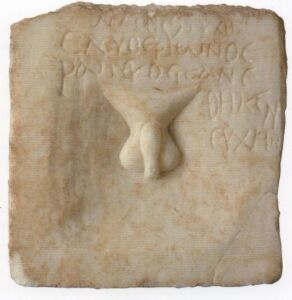 There are hundreds of votive offerings, plaques, and reliefs, testifying to the fact that the therapy was successful (Stampolides 2014). The picture to the left depicts a penis and the hypogastrium and was dedicated according to the inscription by Eleutherion, in gratitude for his cure.
There are hundreds of votive offerings, plaques, and reliefs, testifying to the fact that the therapy was successful (Stampolides 2014). The picture to the left depicts a penis and the hypogastrium and was dedicated according to the inscription by Eleutherion, in gratitude for his cure.
Famous Therapeutes of Antiquity who practiced incubation.
Asklepios (mythic era), Machaon (Trojan war), Orpheas (mythic era), Melampous (mythic era), Pythagoras of Samos (570-495), Parmenides of Elaia (540- 475), Empedocles of Akragantas (495-435), Hippocrates of Kos (460-370 BC), Rufus of Ephesus (late 1st century AD), Galen of Pergamon (120-200 AD) are some to name the most famous.
Hippocrates is well known as the father of modern medicine. He was the chief priest of the Asklepeion at Kos. He wrote a lot of treatises on medicine. The Oath that doctors give today is attributed to him.
The end of the Asklepieia.
There is strong evidence to suggest that these sanctuaries operated long before 1000 BC and ended around 330 AD by an edict issued by Roman Emperor Constantine. In those edicts it was clearly stated that “the sole and only savior is Jesus Christ and no other has the right to cure, or heal”… All the Asklepieia were brought down and their operation ceased. From there on society gradually slipped into medieval times…
Conclusion
For all good and evil, whether in the body or in human nature, originates, as he declared, [The Thracian physician and student of Zalmoxis] in the soul, and overflows from thence, as if from the head into the eyes. And therefore if the head and body are to be well, you must begin by curing the soul; that is the first thing. And the cure, my dear youth, has to be effected by the use of certain charms, and these charms are fair words; and by them temperance is implanted in the soul, and where temperance is, there health is speedily imparted, not only to the head, but to the whole body. And he who taught me the cure and the charm at the same time added a special direction: ‘Let no one,’ he said, ‘persuade you to cure the head, until he has first given you his soul to be cured by the charm. For this,’ he said, ‘is the great error of our day in the treatment of the human body, that physicians separate the soul from the body.
Socrates from the Charmides dialogue written by Plato
If after reading all this you ask me: “Why do I need to know all this?” Then I either did not make my point, or, you are not a therapist. If we are to call ourselves therapists then we have to know from where we have come from and from how far. We must know that not only the words and the white garments that we still use today originate from the Asklepieia, but even the essence of therapy derives from there.
Most modern therapies are inefficient. Modern psychotherapy is also not as effective as it could be. Therapists cannot limit sessions in an office setting no matter how attractive that setting might be. Neither therapy can be limited in fifty minute sessions. Therapists cannot disregard nature and treat people as separate beings that are not connected to the surrounding cosmos.
If we want to be helpful and effective therapists, we also have to look back to what our ancestors did and learn from their practices. More specifically regression therapists have a way in touching the core issue of their clients. Whether they induce trance or not, they still bring up the somatic, the emotional and the mental abreactions necessary to bring deep healing and radical change. My assertion is that regression therapists are closer to the great healers of the Asklepieia than any other colleague from mainstream psychotherapy and they are the ones who facilitate enorasis to their clients.
Comment
This article would be incomplete without having references to the beliefs of ancient Greeks to the Beyond and the Afterlife. The author’s next article will deal with this very important part so that readers will have the larger picture which directly relates with our findings in our practices.
References
Barasch, M. I. (2000). Healing dreams; Exploring the dreams that can transform your life. New York: Riverhead Books.
Edelstein, E. J. & Edelstein, L. (1998). Asclepius; Collection and interpretation of the testimonies. Baltimore, MD: Johns Hopkins University Press.
Ellenberger, H. F. (1970). The discovery of the unconscious; The history and evolution of dynamic psychiatry. New York: Basic Books.
Kingsley, P. (1999). In the dark places of wisdom. Inverness, CA: The Golden Sufi Center.
Kontaratos, A. (1999). The ancient Greek mysteries. Athens, Greece.
Moody, R. (1993). Reunions; Visionary encounters with departed loved ones. New York: Villard Publishing.
Moss, R. (2010). The Secret history of dreaming. Novato, CA: New World Library.
Stampolidis, N., & Y. T. (Eds.) (2014). HYGEIA: Health, illness, treatment; From Homer to Galen. Museum of Cycladic Art.
Tick, E. (2001). The practice of dream healing; Bringing ancient Greek mysteries into modern medicine. Wheaton, IL: Quest Books
Encounters with departed loved ones. New York: Villard Publishing.
Moss, R. (2010). The Secret history of dreaming. Novato, CA: New World Library.
Stampolidis, N., & Y. T. (Eds.) (2014). HYGEIA: Health, illness, treatment; From Homer to Galen. Museum of Cycladic Art.
Tick, E. (2001). The practice of dream healing; Bringing ancient Greek mysteries into modern medicine. Wheaton, IL: Quest Books
[1] Doric rhythm is a simple and thrifty style as opposed to the Corinthian which is an artistic and far more complex style of columns.

